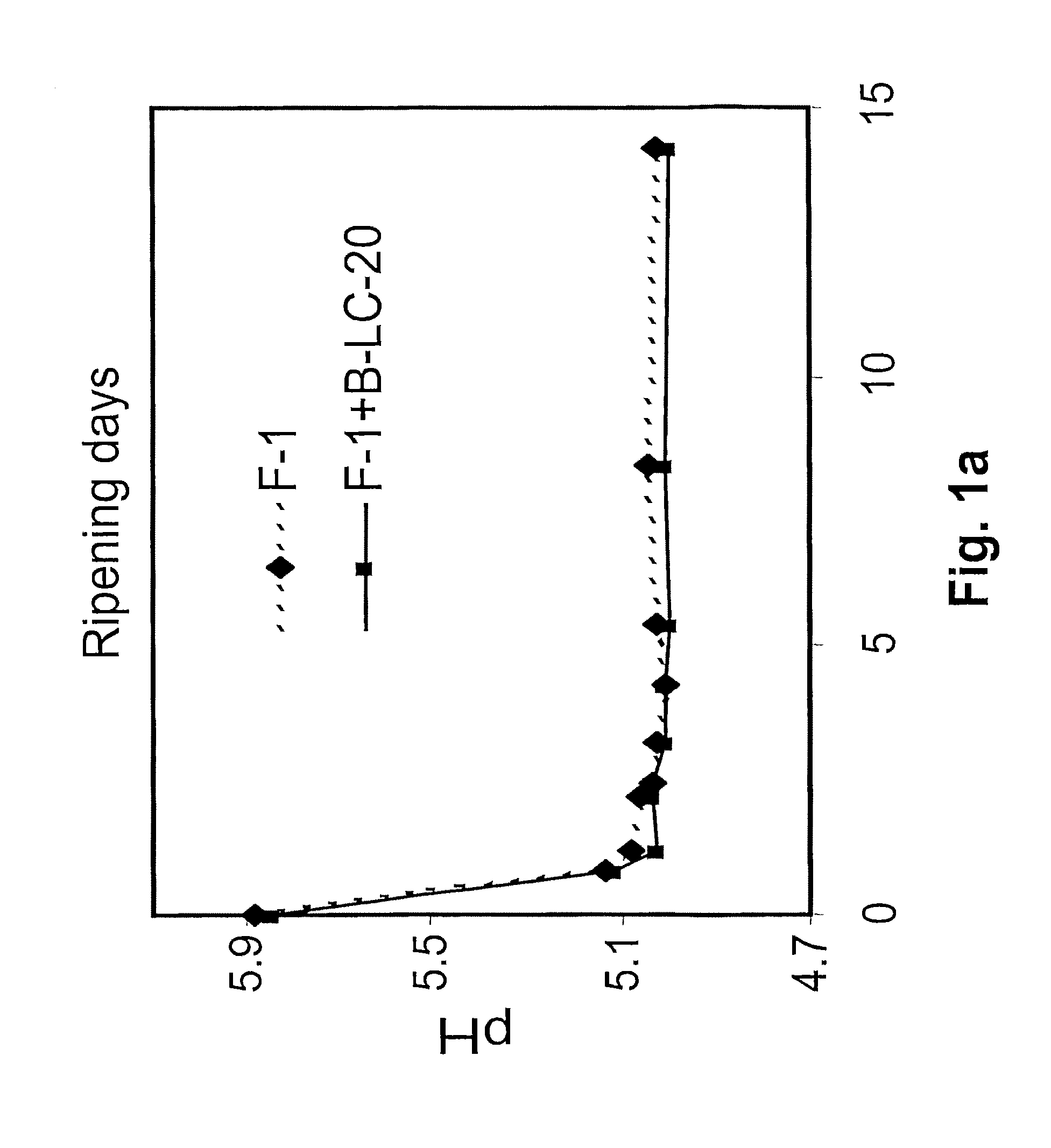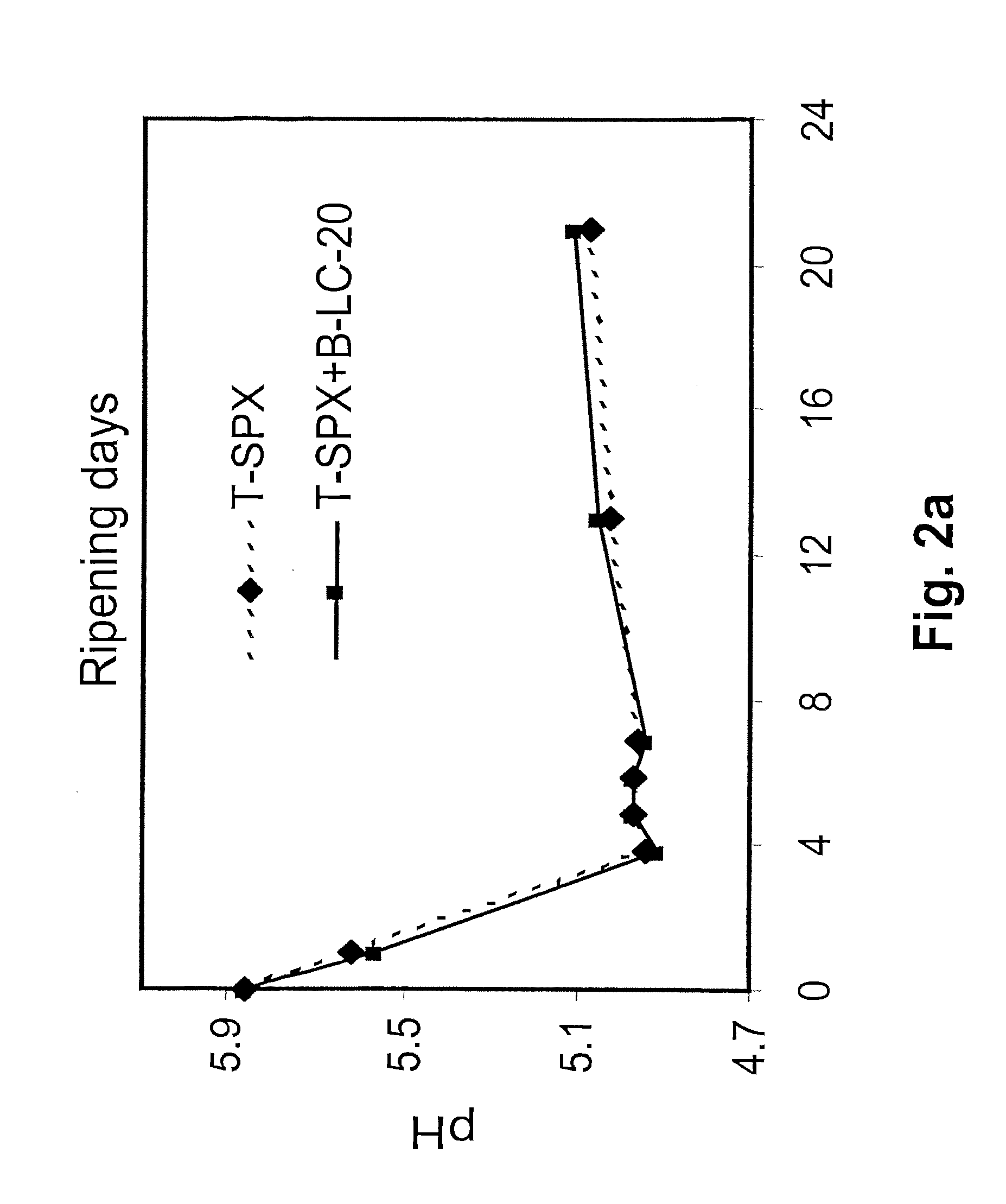Method for reducing the content of pathogenic organisms present in food materials
a technology of pathogenic organisms and food materials, applied in the field of improving microbial safety, can solve the problems of serious safety problems, the presence of pathogenic organisms, listeria monocytogenes /i>, etc., and achieve the effect of high production of bacteriocin
- Summary
- Abstract
- Description
- Claims
- Application Information
AI Technical Summary
Benefits of technology
Problems solved by technology
Method used
Image
Examples
example 1
[0076]Influence of B-LC-20 on pH Development in Sausage Mince.
[0077]The influence of the adjunct culture on acidification is demonstrated and a summary of the pH / time profiles encountered when applying B-LC-20 to sausage mince. Table 1 shows the pH development during the fermentation period as determined every second day and table 2 shows the pH development as determined continuously from 0 to 68 hours.
TABLE 1pH development in sausage mince determined each second dayCodeDay 0Day 2Day 4Day 6Control (starter5.79 ± 0.044.81 ± 0.034.80 ± 0.044.79 ± 0.01culture)Control +5.79 ± 0.014.77 ± 0.014.77 ± 0.014.80 ± 0.04B-LC-20
TABLE 2pH development in sausage mince determinedby continuous measurementHoursCode010203040506068Control (starter5.625.715.585.164.974.864.794.77culture)Control +5.625.705.555.124.914.804.764.76B-LC-20
[0078]The results show that there is no significant influence on the final pH of adding the adjunct culture in form of B-LC-20 together with the control culture as compared...
example 2
[0081]Influence of B-CL-20 on Listeria reduction
[0082]Summary of Trials
[0083]Two independent trials to assess the behavior of Listeria in sausages along the ripening process were performed. Three batches were manufactured in each trial. One with the control starter culture non active against Listeria and two batches with the control starter culture together with an antilisteria starter culture added at two different concentrations (B-LC-20, Chr. Hansen A / S). Each batch was inoculated with a cocktail of five Listeria monocytogenes strains (approx. 103 CFU / g) at the time of manufacturing.
[0084]Ripening was done in an adapted versatile environment test chamber Sanyo Model MLR-350H, with a fermentation period for 72 h at 14° C. with 80%RH.
[0085]At the selected times three sausages were sampled from each batch for determining Listeria and Lactic acid Bacteria counts, pH and weight loss.
[0086]The behavior of Listeria was similar in both trials, showing important differences between the co...
example 3
[0124]Influence of the Adjunct Culture on the Acidification Profile of Different fermented Sausages
[0125]The influence of the adjunct culture B-LC-20 on the acidification profile of four types of sausages fermented with different starter cultures are demonstrated in FIGS. 1 and 2. In all cases, the addition of the adjunct culture in the sausage mince together with the starter culture did not influence the acidification profile of the sausages significantly. In addition, internal sensory evaluations showed that the sensory quality of the sausages was unchanged by addition of B-LC-20.
PUM
 Login to View More
Login to View More Abstract
Description
Claims
Application Information
 Login to View More
Login to View More - R&D
- Intellectual Property
- Life Sciences
- Materials
- Tech Scout
- Unparalleled Data Quality
- Higher Quality Content
- 60% Fewer Hallucinations
Browse by: Latest US Patents, China's latest patents, Technical Efficacy Thesaurus, Application Domain, Technology Topic, Popular Technical Reports.
© 2025 PatSnap. All rights reserved.Legal|Privacy policy|Modern Slavery Act Transparency Statement|Sitemap|About US| Contact US: help@patsnap.com



